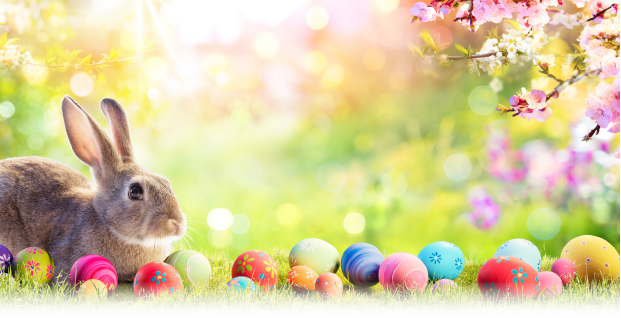
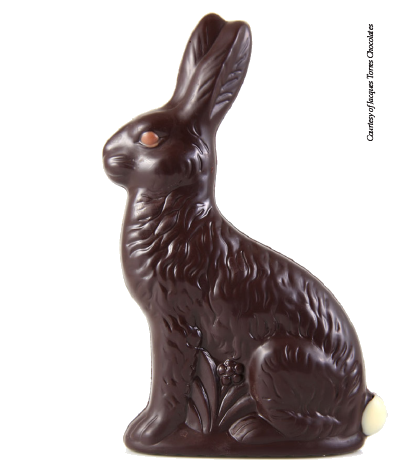
Easter traditions are some of the most joyous of the year—but with magical rabbits, rainbow-hued colored eggs, and baskets filled with favorite confections, we wondered how these all originated. The history of Easter celebrations is a colorful one, and while some have little, if anything, to do with the religious aspect, that doesn’t mean they aren’t a lot of fun. From Easter bunnies to a traditional lamb dinner, here are some traditions to give your celebrations even more meaning for you and your family.
THE HISTORY
Many believe some Easter traditions have been inspired by pagan celebrations, right down to the name itself. Eostre—also called “Ostara” and “Eastre”—is the pagan goddess of dawn, and she was often celebrated and honored around the spring equinox. In artistic depictions of Eostre, she usually carries a woven basket and has eggs and hares around her, representing fertility and new life.
For most young and not-so-young, a chocolate bunny or egg is a fun way to celebrate the spring holiday. But have you ever wondered why we give chocolate on Easter? While Easter is an important holiday for many, people of all faiths partake in fun traditions such as dyeing eggs and Easter Egg Hunts. These secular celebrations have rich histories worth remembering while shopping for chocolate eggs, bunnies, jelly beans, and peeps. As Anthony Cirone, co-owner of Li-Lac Chocolates, told us, “Easter is our second busiest season of the year, following Christmas. It’s our most colorful and fun holiday with many spring colors and flavors; personally, it’s my favorite holiday. At Li-Lac Chocolates, we have a historical collection of antique Easter molds dating back to the early 1900s, which we still use today.”
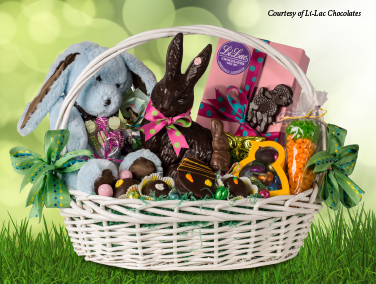
THE SWEET TREATS
Easter Egg The first chocolate Easter Eggs were created in England in the 1800s; they quickly gained popularity across Europe, especially in Germany and France, with some eggs being solid chocolate. Joan Coukos of Chocolat Moderne told us recently that she remembers Easter Sundays growing up in a Greek household. “We played a game where everyone held an egg and took a turn tapping the top of someone’s egg. If your egg cracked, then it was your turn to crack the bottom of their egg. If you succeeded, it was told that you would be showered with good luck.” Indeed, it inspires Coukos and many of her Easter confections today.
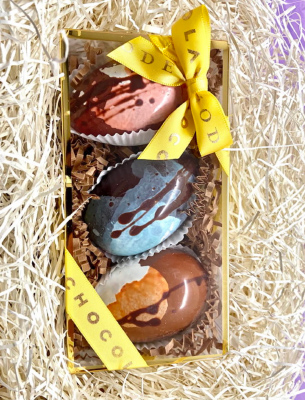
Easter Bunny Chocolate bunnies stem back to the 1800s in the U.S. when German immigrants brought the celebratory candy with them. Today, the tradition continues with expert care from Jacques Torres, better known to most as “Mr. Chocolate,” who tells us, “I translate my love of working with chocolates that are loved by all ages into something bigger.” His Easter Collection is always something special.
At Royce Chocolates, everything is flown in from Japan. The best-selling nama chocolates come as close to melting in your mouth as chocolates can, thanks to Hokkaido fresh cream. If you’ve never had these Japanese chocolates, the butter-like texture can come as a surprise, as they are meant to replicate the inside of a truffle. This Easter look for Easter Hunt set, Sweet Eggs, and so much more!
Jelly Beans They didn’t start as an Easter-specific treat and were a typical candy in the Victorian era. It wasn’t until the 1930s that the colorful candies became a popular post-Lent indulgence, and the reason was simple: Their ovoid shape reminded people of Easter eggs.
Marshmallow Peeps In 1910, Russian immigrant Sam Born came to the United States at just 19 years old, and by 1917 had a candy store in Brooklyn with a “Just Born” display in its window to show the newest, freshest offerings. 1923 Born began his Just Born candy manufacturing company, eventually expanding into Bethlehem, Pennsylvania. And, well, the rest is history. Today, you can find peeps in every color of the rainbow.
The Easter Basket Like the Easter Bunny, the practice of the Easter Basket likely began in Germany. Once children started to think the “Easter Hare” would leave goodies, they created small nests in their gardens where the bunny could place their treats. Today, Easter Baskets are brimming with bunnies and eggs surrounded with colorful jelly bean and marshmallow peeps.
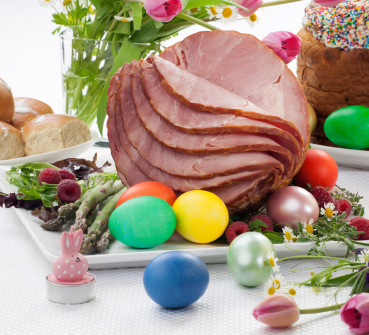
TRADITIONAL EASTER FOODS
Hot Cross Buns They were first popularized for Easter in England in the 1100s. However, like many Christian traditions in Europe surrounding the holiday, hot cross buns were around for a long time before that when they were associated with paganism. The Greeks and Romans appropriated the tradition from yet another culture: ancient Egyptians used small, round loaves of bread decorated with crosses as offerings to their gods. Today, they are consumed during the forty days leading up to Easter.
Easter Cuisine Lamb is a traditional Easter food. Though it also has roots in early Passover celebrations. The Bible tells us the people of Egypt suffered plagues, including the death of all firstborn sons. It’s because of this the Israelites painted their doorposts with sacrificed lamb’s blood with the hope that it would “pass over” their homes. The tradition continued with Jews who converted to Christianity by serving lamb at Easter. Another traditional main course is ham. It’s said that pigs were slaughtered in the autumn harvest season and cured throughout the winter. By Easter season, the ham was ready to be cooked and enjoyed.
For more information on Chocolat Moderne, visit, chocolatemoderne.com;
Jacques Torres Chocolate, visit mrchocolate.com;
Li-Lac Chocolates, visit li-lacchocolates.com;
Royce’, visit royce.com




